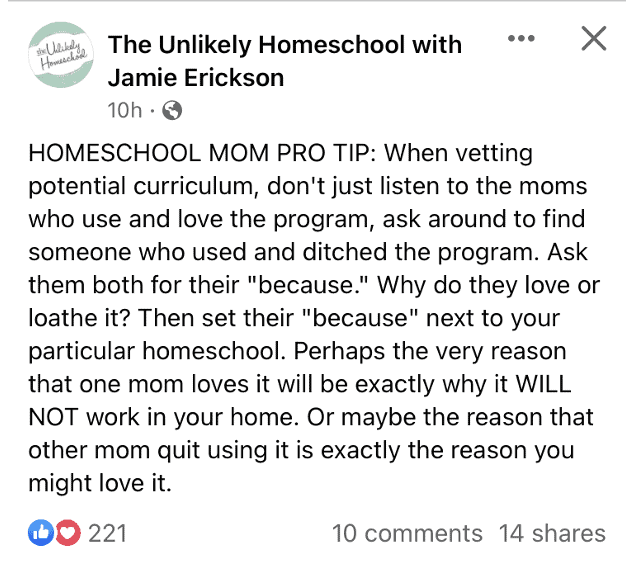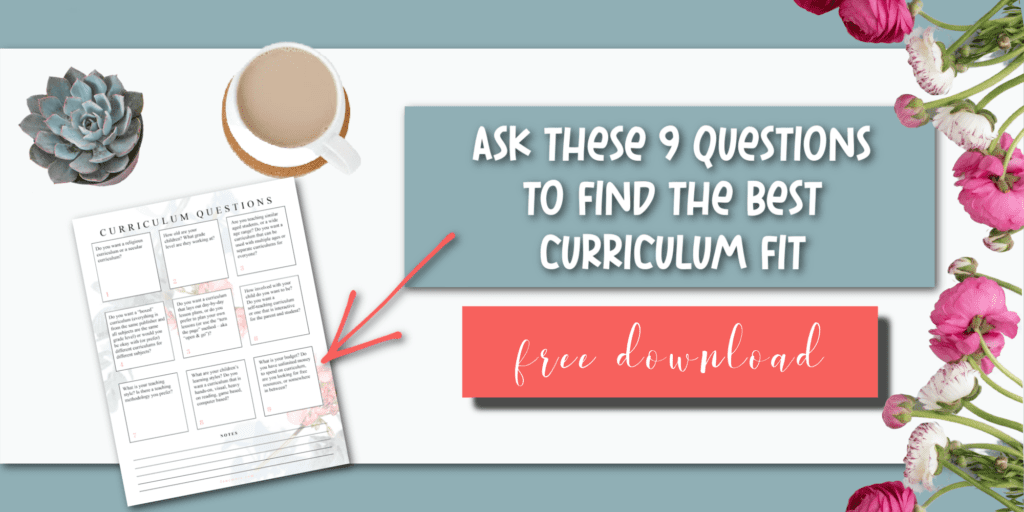Years ago I realized that the boxed curriculum, or those textbooks and workbooks that were make for a classroom, really didn’t translate well into our homeschool. So we soon became eclectic homeschoolers who look for open & go homeschool-friendly resources. Here’s why we made that change and why you might want to make it too.

My posts contain affiliate links.
What is boxed curriculum?
When I refer to boxed curriculum here, I’m talking about strict, inflexible curriculum that is made for a traditional school setting. It might be used by homeschoolers, but it usually comes with a teacher’s guide that assumes you’re teaching a classroom full of kids. It might have lots of busywork and worksheets. It might assume you need to spend time lesson planning.
In short, a boxed curriculum is not typically homeschool-friendly and you usually can’t use it to teach multiple kids or ages together. And it’s likely in a textbook style.
Now, if you’re wondering about the many homeschool styles that are out there, definitely check out our free resource that will help you wade through the differences and figure out which style would work best for your family.
Here’s one more excellent free resource that will walk you through the main questions to ask to choose the best curriculum for your family.
Listen to episode 236
On episode 236 of the Homeschool with Moxie Podcast, we talk about why I ditched the boxed curriculum. The inspiration for this episode came from a “Homeschool Mom Pro Tip” from The Unlikely Homeschool with Jamie Erickson on Facebook. We had Jamie as a guest on the podcast on episode 21 to talk about her book, Homeschool Bravely.
Here’s the post on Facebook and the jumping off point of this episode.

Sometimes the boxed curriculum – strict, inflexible, traditional, school-at-home curriculum – makes homeschooling way harder than it needs to be! Here’s why I ditched the boxed curriculum years ago and you might want to ditch it too.
Here’s why I ditched that boxed curriculum
Boxed curriculum just wasn’t homeschool-friendly. Here’s why we ditched it.
- I didn’t need a teacher’s book with multiple ways to teach to a full classroom of kids.
- Plus I didn’t want to have to consult the lesson plans each day to know what to do.
- I didn’t want to have to juggle multiple resources just to complete one subject.
- It’s usually too narrowly focused on one grade level and harder to use with multiple ages.
- Boxed curriculum is usually busy-work focused – lots of consumables and worksheets. (I don’t use printables – here’s what I use instead.)
- It’s not open & go
- It can be expensive!
- We didn’t want to do school at home. (now if you do want to do school at home, then this doesn’t apply to you)
- Homeschooling is different than going to school with a traditional school setting. While you may have the same worldview, the methodologies are light years apart. If I ever set foot in a traditional classroom again, my teaching will be waaaay different BECAUSE I was a homeschool mom (even though I have my teaching degree). Here’s why you can do a wonderful job homeschooling without a teaching degree.


Heya.
In order to have a choice I look at questions on exam papers and adapt ones I find in commercially produced workbooks at the local bookstore too. I also read up on subject requirements and levels of our national curriculum. That information helps me decide what to do next. I’m a keen believer in quality over quantity here all the way. Best wishes. Nice to meet you. I do like to have a flexible lesson plan to use however. It eases my stress.
I focus on teaching skills through play as much as possible. We do a ton of play dates at the closest library where they have a soft play area and so on. I also rarely give out homework each term. I believe education should be truly meaningful and fun at the same time. In lieu of daily homework tasks I only set the children a fun homework exercise each fortnight. The homework questions vary. For example the homework might be to plan a Halloween party or to decide a Christmas menu in question. Or the homework may be to study a artist and make some brief summary notes on findings.
At other times the homework is to read a new story and think of ten original math questions. Homework really needs to be fun. And it can be. Recently we visited a new museum and had lunch by a river. Their homework task that week was to write a recount of their trip to that museum. I also told them to find out a bit more about the town online. We drew a map. My kids love homework.